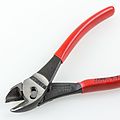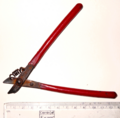Diagonal pliers
This article needs additional citations for verification. (January 2022) |

Diagonal pliers (also known as wire cutters or diagonal cutting pliers, or under many regional names) are pliers intended for the cutting of wire (they are generally not used to grab or turn anything). The plane defined by the cutting edges of the jaws intersects the joint rivet at an angle or "on a diagonal", hence the name.
Action
Instead of using a shearing action as with
Jargon
Diags, dykes or dikes is
In
Insulation
The
Uses
Diagonal pliers are useful for cutting copper, brass, iron, aluminium and steel wire. Lower quality versions are generally not suitable for cutting tempered steel, such as piano wire, as the jaws are not hard enough. Attempting to cut such material will usually cause indentations to be made in the jaws, or a piece to break out of one or both jaws, thus ruining the tool. However higher quality side cutters can cut hardened steel, such as 2 mm piano wire.
Variations
For electronics work, special diagonal cutters that are ground flush to the apex of the cutting edge on one side of the jaws are often used. These flush-cutting pliers allow wires to be trimmed flush or nearly flush to a solder joint, avoiding the sharp tip left by symmetrical diagonal cutters. It is common for this type of diagonal cutter to be referred to by another name, such as flush cutter to distinguish it from symmetrical cutters.
For easier cutting of larger gauge wire, a compound action can be employed to increase the mechanical advantage.
Some
Other variations are made to create high leverage specifically to cut through hard wire, such as electrical fence wire, dental wire, and piano wire.
Gallery
-
Wire cutting with a shearing action







